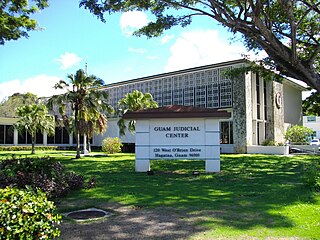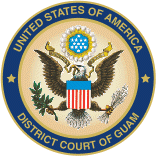
The demographics of Guam details an array of demographic statistics relating to the territory of Guam. This includes statistics on population, including the Indigenous population; religious affiliations; language; and immigration. The Demographics of Guam provides an overview of the history of Guam, as well as a depiction of the villages in the United States territory and its populace. The population of Guam, as of July 2021 was 168,801.

Territories of the United States are sub-national administrative divisions overseen by the federal government of the United States. The various American territories differ from the U.S. states and Indian reservations as they are not sovereign entities. In contrast, each state has a sovereignty separate from that of the federal government and each federally recognized Native American tribe possesses limited tribal sovereignty as a "dependent sovereign nation". Territories are classified by incorporation and whether they have an "organized" government through an organic act passed by the Congress. American territories are under American sovereignty and, consequently, may be treated as part of the United States proper in some ways and not others. Unincorporated territories in particular are not considered to be integral parts of the United States, and the Constitution of the United States applies only partially in those territories.

The Chamorro people are the Indigenous people of the Mariana Islands, politically divided between the United States territory of Guam and the encompassing Commonwealth of the Northern Mariana Islands in Micronesia, a commonwealth of the US. Today, significant Chamorro populations also exist in several U.S. states, including Hawaii, California, Washington, Texas, Tennessee, Oregon, and Nevada, all of which together are designated as Pacific Islander Americans according to the U.S. Census. According to the 2000 Census, about 64,590 people of Chamorro ancestry live in Guam and another 19,000 live in the Northern Marianas.

The Democratic Party of Guam is a political party in Guam affiliated with the U.S. Democratic Party. Its origins lie in the Popular Party, which was the only political party on Guam until 1956.
The United States territorial courts are tribunals established in territories of the United States by the United States Congress, pursuant to its power under Article Four of the United States Constitution, the Territorial Clause. Most United States territorial courts are defunct because the territories under their jurisdiction have become states or been retroceded.

Juan Rafael Torruella del Valle Sr. was a Puerto Rican jurist. He served as a United States circuit judge of the United States Court of Appeals for the First Circuit from 1984 until his death, and as chief judge of that court from 1994 to 2001. He was the first Hispanic to serve on the First Circuit, which includes Puerto Rico.
Benjamin Joseph "BJ" Franquez Cruz is a Chamorro lawyer, jurist, and politician who served as the Speaker of the 34th Guam Legislature from 2017 to 2018 and as Vice Speaker from 2009 to 2017. A member of the Democratic Party, he previously served in the Guam Legislature from 2005 to 2007 and again from 2008 to 2018. He was Chief Justice of the Guam Supreme Court from 1999 to 2001. In September 2018, Cruz was elected to serve as Public Auditor of Guam.

The Supreme Court of Guam is the highest judicial body of the United States territory of Guam. The Court hears all appeals from the Superior Court of Guam and exercises original jurisdiction only in cases where a certified question is submitted to it by a U.S. federal court, the Governor of Guam, or the Guam Legislature. The Supreme Court of Guam is the ultimate judicial authority on local matters. In the past, appeals of questions involving the U.S. Constitution or federal laws or treaties were heard by a three-judge appellate panel of the U.S. District Court of Guam, from which appeals could be further taken to the United States Court of Appeals for the Ninth Circuit, but this is no longer the case. Since 2006, the court's decisions have only been appealable to the Supreme Court of the United States, in line with the practice regarding the highest courts of the 50 states. The Court sits in the Monessa G. Lujan Memorial Courtroom, which is on the third floor of the Guam Judicial Center in Hagatna, Guam.

The District Court of Guam is a United States territorial court with jurisdiction over the United States territory of Guam. It sits in the capital, Hagåtña. Appeals of the court's decisions are taken to the United States Court of Appeals for the Ninth Circuit. It is not an Article III court, and therefore its judges do not have life tenure, but are appointed to ten-year terms.
The Government of Guam (GovGuam) is a presidential representative democratic system, whereby the president is the head of state and the governor is head of government, and of a multi-party system. Guam is an organized, unincorporated territory of the United States with policy relations between Guam and the US under the jurisdiction of the Office of Insular Affairs.

The District of Columbia and United States Territories quarters were a series of six quarters minted by the United States Mint in 2009 to honor the District of Columbia and the unincorporated United States insular areas of Puerto Rico, Guam, the United States Virgin Islands, American Samoa, and the Northern Mariana Islands. The islands commonly grouped together as the United States Minor Outlying Islands were not featured, as the law defined the word "territory" as being limited to the areas mentioned above. They followed the completion of the 50 State Quarters Program. The coins used the same George Washington obverse as with the quarters of the previous 10 years. The reverse of the quarters featured a design selected by the Mint depicting the federal district and each territory. Unlike on the 50 State quarters, the motto "E Pluribus Unum" preceded and was the same size as the mint date on the reverse.

Gustavo Antonio Gelpí Jr. is an American lawyer who serves as a United States circuit judge of the United States Court of Appeals for the First Circuit. He is a former chief United States district judge of the United States District Court for the District of Puerto Rico.
Elizabeth Barrett-Anderson is a Guamanian lawyer, judge, and moderate Republican politician. She served as the sixth and thirteenth Attorney General of Guam, a U.S. territory, from 1987 to 1994 and from 2015 to 2019. She is the longest-serving attorney general in Guamanian history and was the first woman to serve as attorney general.

Edward Eladio Manibusan is a Northern Marianan attorney and politician serving as the first elected Attorney General of the Northern Mariana Islands. He took office on January 12, 2015. He previously served in the position from July 1, 1989 to January 8, 1990 when it was a gubernatorial appointment.

Edward De Leon Guerrero Pangelinan was a politician from the Northern Mariana Islands. He served as the Chairman of the Marianas Political Status Commission and later as the 1st Resident Representative from the Northern Mariana Islands to the United States House of Representatives.
Marilyn D.A. Manibusan is a Guamanian politician. Manibusan is a former Republican senator in the Guam Legislature. Manibusan is the first chairwoman of the Republican Party of Guam.











